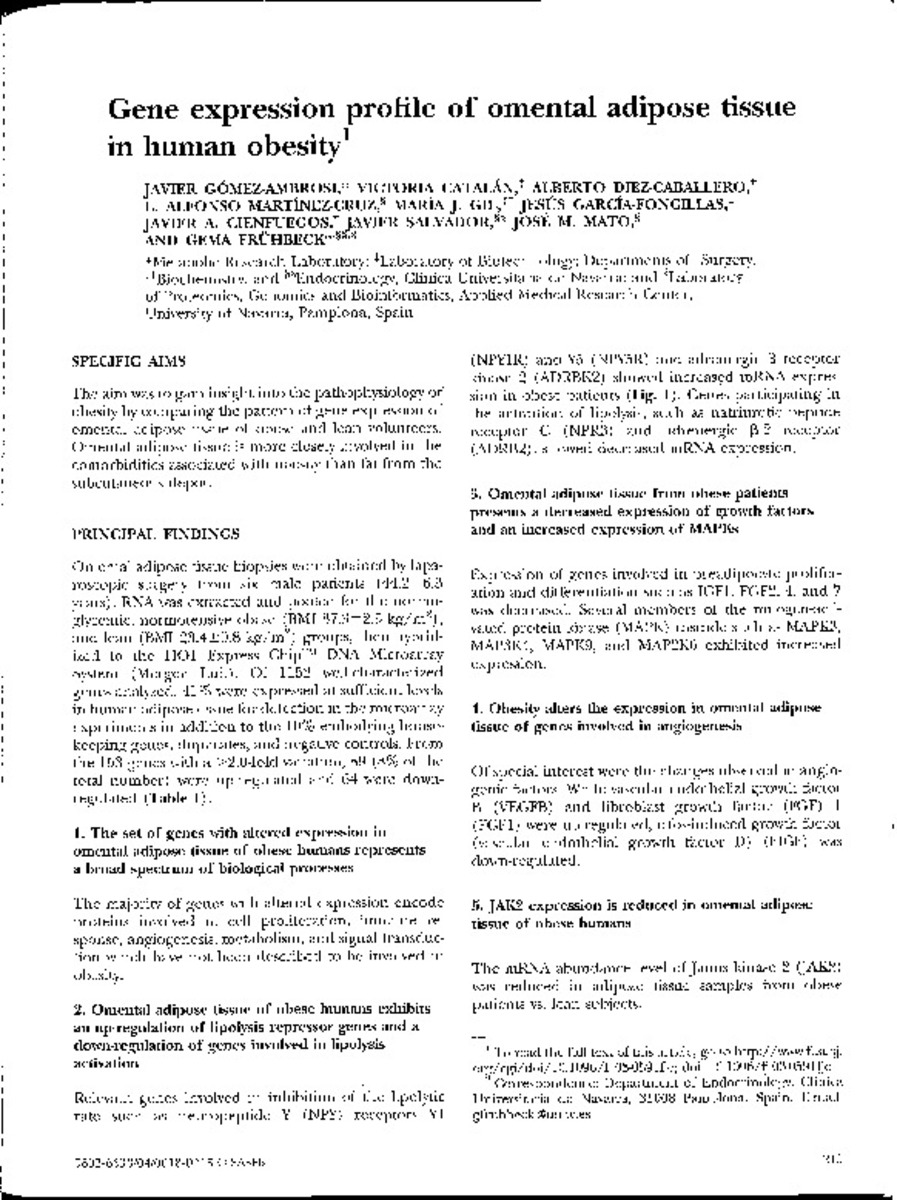Full metadata record
| DC Field | Value | Language |
|---|---|---|
| dc.creator | Gomez-Ambrosi, J. (Javier) | - |
| dc.creator | Catalan, V. (Victoria) | - |
| dc.creator | Diez-Caballero, A. (Alberto) | - |
| dc.creator | Martinez-Cruz, L.A. (L. Alfonso) | - |
| dc.creator | Gil, M.J. (María José) | - |
| dc.creator | Garcia-Foncillas, J. (Jesús) | - |
| dc.creator | Álvarez-Cienfuegos, J. (Javier) | - |
| dc.creator | Salvador, J. (Javier) | - |
| dc.creator | Mato, J.M. (José María) | - |
| dc.creator | Frühbeck, G. (Gema) | - |
| dc.date.accessioned | 2012-05-08T15:31:10Z | - |
| dc.date.available | 2012-05-08T15:31:10Z | - |
| dc.date.issued | 2004 | - |
| dc.identifier.citation | Gomez-Ambrosi J, Catalan V, Diez-Caballero A, Martinez-Cruz LA, Gil MJ, Garcia-Foncillas J, et al. Gene expression profile of omental adipose tissue in human obesity. FASEB J 2004 Jan;18(1):215-217. | es_ES |
| dc.identifier.isbn | 0892-6638 | - |
| dc.identifier.uri | https://hdl.handle.net/10171/21972 | - |
| dc.description.abstract | The aim of the present study was to gain insight into the pathophysiology of obesity by comparing the pattern of gene expression of omental adipose tissue of obese and lean volunteers using DNA microarrays. Omental adipose tissue biopsies were obtained by laparoscopic surgery from six male patients (44.2±6.3 yr). RNA was extracted and pooled for the obese (BMI: 37.3±2.5 kg/m2) and lean (BMI: 23.4±0.8 kg/m2) groups. From the total number of genes analyzed (1,152 well-characterized human genes), 41% were expressed at sufficient levels in human adipose tissue for detection in the microarray experiments, finding that 89 genes were upregulated while 64 were down-regulated at least twofold in the omental adipose tissue obtained from obese patients. We found a general tendency to blunt lipolysis inducer genes and a global down-regulation of genes encoding growth factors. Moreover, an up-regulation in the expression of several mitogen-activated protein kinases (MAPKs) was observed. The down-regulation of genes involved in lipolysis activation may be involved in the etiopathogenesis of obesity. In addition, down-regulation of growth factors and the up-regulation of MAPKs may indicate an attempt to restrain adipocyte proliferation and differentiation. Furthermore, obesity is accompanied by an altered expression in omental adipose tissue of genes involved not only in energy homeostasis but also in quite diverse biological functions, such as immune response. The genomic approach underlines the importance of adipose tissue beyond energy metabolism. | es_ES |
| dc.language.iso | eng | es_ES |
| dc.publisher | Federation of American Society of Experimental Biology | es_ES |
| dc.rights | info:eu-repo/semantics/openAccess | es_ES |
| dc.subject | Adipocytes | es_ES |
| dc.subject | DNA microarrays | es_ES |
| dc.subject | Lipolysis | es_ES |
| dc.subject | Metabolism | es_ES |
| dc.title | Gene expression profile of omental adipose tissue in human obesity | es_ES |
| dc.type | info:eu-repo/semantics/article | es_ES |
| dc.type.driver | info:eu-repo/semantics/article | es_ES |
| dc.identifier.doi | http://dx.doi.org/10.1096/fj.03-0591fje | es_ES |
Files in This Item:
Statistics and impact
Items in Dadun are protected by copyright, with all rights reserved, unless otherwise indicated.






